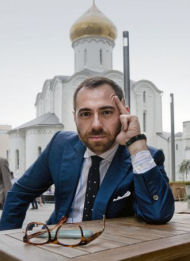|
|
|
|
Who said that there is no such thing as real, true, everlasting love? The liar’s evil tongue should be cut out! Follow me reader and
I will show you this kind of love!
At this point, all you readers and guests who are preparing to visit Moscow, you might be expecting me to tell you about that real,
true, everlasting love; however, in keeping with the rules, I am going to talk about Moscow, leaving those that are curious or more
romantic, to read and reread “The Master and Margarita” by Bulgakov, from which the excerpt is taken and which is set in Moscow.
Why was this book set in Moscow? Because, as most people think, a book that is so visionary, ironic, romantic and mystic could not
possibly be set in any other city in the world.
I first came to Moscow on the 9th of February 2009 – every foreigner who lives here remembers the date they arrived for the first
time - thanks to (or because of) the book by Bulgakov and a girl who gave it to me as a gift a long time ago: women always have
something to do with the most crazy choices in a man’s life! My first contact with the city came as a shock, and obviously I’m not
just talking about the cold.
I immediately saw an urban space, infinite and endless, destabilising and not open to comparison with any other western capital
which I had visited up until then. With time, I understood that it is Russia’s history that cannot be compared to that of any
other country, and consequently, its capital could has to be the dynamic representation of that history. I also discovered that
there is not just one Moscow, there are ten, perhaps twenty; one for each segment of the onion-shaped domes that adorn St. Basil’s Cathedral.
There is the pre-revolutionary Moscow of the aristocratic pastel-coloured palaces that communist rule converted to use by the
state as the headquarters for the countless components of what was then the Soviet bureaucracy and is now the Russian equivalent.
There is the Stalinist Moscow of the Fifties: the imperial city resulting from the triumph of the Second World War, with its
impressive buildings and roads with dozens of lanes; infrastructure and sizes worthy of what was supposed to become the capital
of the world (“Moscow, stolitza mira” (Mira capital), they said); there is the post-Stalin Moscow of Khrushchev, and its sad
khruschyovkas, low-cost 4 or 5-storey buildings characterised by that grey uniformity; and so on and so forth until we reach
contemporary Moscow, similar to the great western capitals, with wide pavements, pedestrian areas and parks. Here, between
lunch in a Georgian restaurant (Sakhli, Elardzhi or Tinatin), a banya or sauna (Sanduni obviously), or a game of golf (weather permitting),
fashions and people are consumed with the typical frenzy of the strongest capitalism.
Moscow nowadays allows everything: you can go to the gym at midnight, eat in a restaurant at 4 in the morning and perhaps go
shopping or out to buy a new bathroom suite at 5 a.m. The only thing you won’t find is banality.
Moscow is not what you would call a beautiful city. Moscow is intriguing, and it fascinates you with your destabilisers.
Moscow welcomes you, it sucks you in, empties you out and then throws you away, before picking you up again. This is the
only way I can explain how I want to escape after spending three or four months there, followed by the desire to return as
soon as I’ve recharged my batteries. And this brings us back to the “Master and Margarita” which, with one of its main characters,
describes the city. Master Woland – who, like you, comes to the city for a party – after completing his mission, seated on a stool,
observes Moscow from the top of a building and, speaking to his manservant Azazello, says “what an interesting city Moscow, don’t
you think?”, the demon answers that he prefers Rome, to which his master replies “yes, this is a matter of taste”.
Dear friends, Moscow will welcome you with open doors but, be warned, as many foreigners who have come here for a short stay and
ended up setting up home and staying for good know, the exit doors are very narrow…
Strongly recommended: spending a couple of hours in banya da Sanduny, and, depending on how much time you have, a trip into the most authentic Russia with a visit to Suzdal.
Giacomo Augugliaro
|
|
|
|
|

|
|
|
|